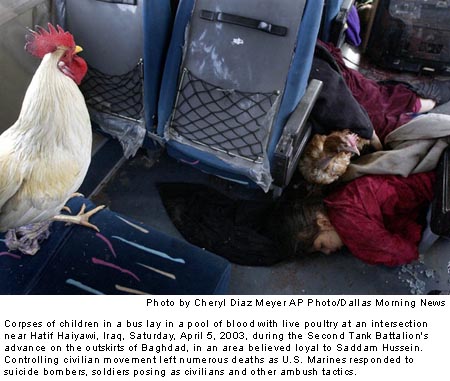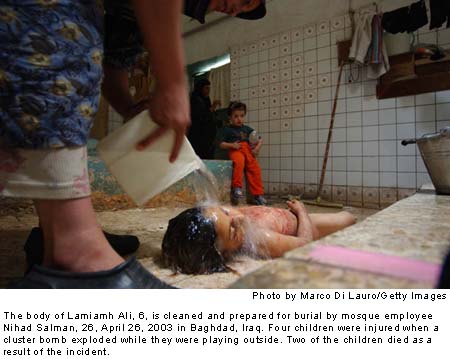I did start to feel overwhelmed having to look at the images of dead, broken human beings that were transmitted from Iraq each day by those courageous photojournalists up at the sharp end. A succession of images of children maimed by modern weapons disturbed my mind and broke my heart. Young soldiers, wounded and dead, American and Iraqi. Snapshots of the dead American and British soldiers provided by their families, taken in happier times at picnics and weddings, with smiling children now bereft and fatherless, some of them left without their mother. Photos now only mementos to fend off the cold reality of sudden, violent death. Some days I could only sit in stunned silence, staring at some of the photos coming in over my computer from half a world away. I am used to images of death but never before in such a stream. Each day required a look through all the services, AP, Getty, Reuters, AFP, NYT, LA Times/Washington Post, mind numbing at times, the search for the photo of the day. This is the first major war of the 21st century, where technology has enabled the world to view in realtime the results of life and death decisions by politicians. At times it was almost voyeuristic. I realized that dwelling on these images was not good for the soul and can lead to mental overload. Still, my job was easy compared to the photojournalists who were seeing it all first hand, enduring hardship to pass on what they had witnessed. Journalists were dying so that the world would have eyes on the battlefield.
There were photos, however, that I wish we would have used. The two shown here were selected in an overall edit but did not make the final cut. They graphically portray the horror. But the reality of newspaper photo editing is that it is part of a business, and there are other factors to consider. This means that one is never able to always have used the most hard-hitting photograph that a photo editor feels should be run. Our duty as is to try to be as honest and accurate as possible, putting forward disturbing images even if in the end the photos are not used. Some newspapers did not serve their readers well, by not publishing images that showed the reality and utter degradation of war, for there is no glorious way to die, and war is really as close to hell on earth as you can get. © Roger Richards
|
|
|
Write a Letter
to the Editor |


 To
their credit, my newspaper's guidelines for using tough pictures, established
during peacetime, were not changed by senior editors to suit the political
climate in America, which has become very intolerant against any questioning
of the absolute correctness of the Iraq war. Norfolk is home of the
largest naval base in the world,
and over 30,000 military personnel from this area were involved at the
height of the
war. With one of our reporters embedded with the US Marines and a
photographer/writer team with the Navy, the hometown angle was told.
So were the
stories about the bombings and civilian deaths.
To
their credit, my newspaper's guidelines for using tough pictures, established
during peacetime, were not changed by senior editors to suit the political
climate in America, which has become very intolerant against any questioning
of the absolute correctness of the Iraq war. Norfolk is home of the
largest naval base in the world,
and over 30,000 military personnel from this area were involved at the
height of the
war. With one of our reporters embedded with the US Marines and a
photographer/writer team with the Navy, the hometown angle was told.
So were the
stories about the bombings and civilian deaths.